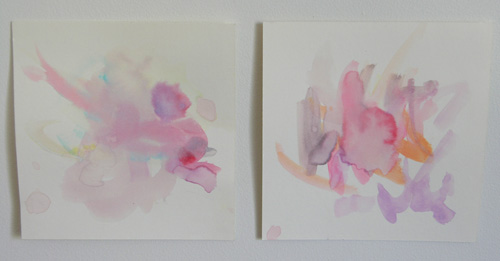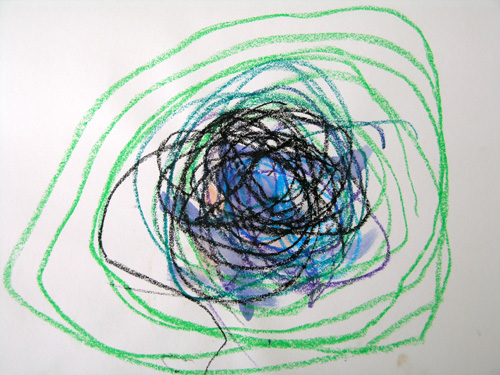Art Not Craft: Conversations in Colour
An adult asked to draw a leaf would generally choose green. Or maybe orange. But what about red, yellow or brown leaves? And what shade of green is ‘right’? The grey-green so prominent in Australian bush settings? Or a lime green of my mulberry tree? Or the deep, dark green of the leaves of my orange tree. All of these colours (and many, many more) would be ‘correct.’
We talk often with young children about colour but regularly these interactions are limited to “What colour is this?” or “What colour is the sky?” I think the response is much more interesting if you ask;
Me: What do you think of when you see this colour? (showing Immy a yellow paint chip)
Immy: Butter. And lemons. And juice. No, not juice – juice is more orange.
Another way to ask would be “What does this colour remind you of?”
Or you could ask;
Which colours are happy colours? Or sad colours? Or mad colours?
Which colours say danger? Or peace?
Which colours are loud colours? Or quiet?
(For more about asking questions which encourage creative thought, visit this post).
When working creatively with children, add interest to their artworks by sometimes;
- Using just warm or cool colours
- Mixing soft, pale pastels (which look great on brown paper)
- Working with white on black, or black on white
- Using metallic crayons, pastels or paints
- Using shades of grey
Are you creative with colour when preparing art experiences for your child?

- How important creativity is to a child’s learning potential
- Practical ideas for making art happen in your home or classroom
- Tips for engaging reluctant artists
- Suggestions for creating and managing an art space
- And much, much more!
Launching Monday, 28th March 2011!




Some great ideas there Christie about conversation during art. thanks. i can’t wait for your e book. Little Eco used to draw with black all the time. It actually worried me at the time. All that black. Thankfully she moved away from black (I’m relieved to know it’s a normal phase) and now uses ‘rainbow’ colours every time. . She sings ‘red and yellow and pink…” and so on, checking that she has each colour. So cute.
Immy was looking at an illustration of a rainbow on a book cover today and was very upset that it had light blue and dark blue because ‘rainbows only need one blue mummy!’ LOL
Oh what a fascinating post! I’ve never thought to discuss colours with Oscar. He has such a vivid imagination and I feel this kind of creative playtime would be right up his ally. For some reason Oscar is drawn to brown paint at the moment, despite the options of vivid reds, blues and yellows. Tomorrow I’m going to ask what he likes about brown, instead of asking why he doesn’t use the more vivid colours. I can’t wait to find out the answer.
Chrissy xx
It’s so interesting how kids identify and relate with colours. Thanks for the interesting post! 🙂
Belly B
http://www.papertiaras.com
Great post. My 4 year old went through the same phase of using black – I think it must be the strong dramatic contrast it gives. Young children especially approach colour with no pre-conceptions so it’s great to explore it a little more creatively, that way we can all learn something!
Thank you for the reminder! I have not asked questions like this very often with my daughter. Am looking forward to your e-book, as I have a reluctant artiste (she is very afraid of “doing it wrong” and it guts me to see her angst over something that looks fine to me but is not what she wanted to draw – I remember the same frustrations when my fingers didn’t draw how I saw the art in my mind! Oh dear…. what have I passed on?!)
Looking forward to seeing the e-book, Christie – I’m hopeless at this stuff, so any tips will be appreciated!!
This is a great post Christy,
I have 2 boys both colour blind to a degree, and I really wonder what it is they see when working with colour. My eldest has done and still does to some extent only like working with black. This was much cause for concern from his prep teacher. Though I’m not sure why. I like the idea of asking the types of questions you’ve outlined. Thanks
I’m looking forward to the ebook too! My girl teaches me so much about colour, she’s a very visual kid and colours were among her first words, and she has always had a strong preference for (nay, obsession with) yellow. She gets frustrated with that “I can sing a rainbow” song, because a) there is no pink in a rainbow and b) the colours are in the wrong order. Ah, the unforgiving logic of a child!
I remember drawing a picture of the sea when I was in kinder, and using green for the sea because I grew up on Port Phillip Bay where the sea is actually green. But I remember being corrected by the other kids because I should have used blue! It’s obviously stuck with me!
I love these ideas. My daughter is not very artistic, but she is very interested in linking colors to feelings. Her favorite color is blue – she says that it’s very cozy.
Hi Christie
A lovely way to talk about the different colours is get a colour sample sheet for acrylic (or oils) from an art store.
For example, Matisse has an entire range of colours for the Australian Landscape including Blue Gum Grey, Australian Sap Green. They are all stunning and demonstrate the huge variations.
Also, it opens up warm and cool colours – Every colour has a warm and cool version which you can buy from art stores. I didn’t realise until i started doing my art course and it does make a huge difference to achieving what you want in a painting.
Interesting post and love the emotions with the colors. Cute ideas!
Angela
http://www.daycareheadquarters.com
Really looking forward to your eBook!
Love your site and I love that you’ve done a post on babies!
My little princess is 6 months and I’m loving how receptive she is to new experiences now! I bought finger paint for her the other day so I can’t wait to see how she reacts to that (and how reactive I can be to stop her from eating it!)